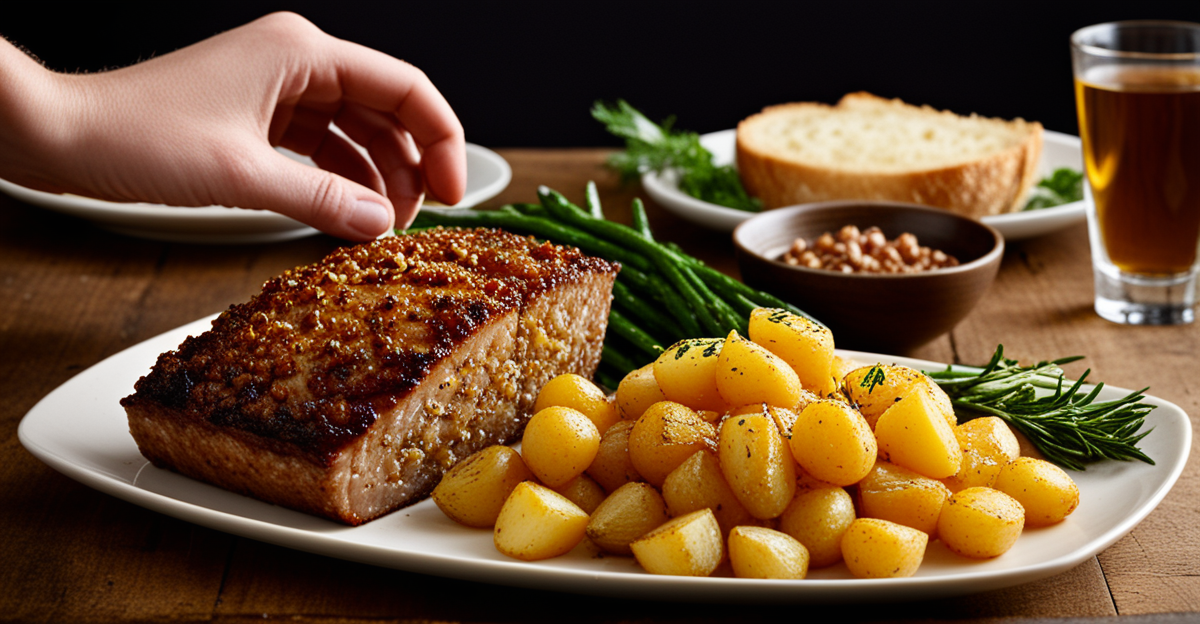Core Proteins in British Dinners
When thinking about traditional British dinners, British meats are central to the authentic experience. Key proteins include beef, lamb, chicken, and pork, each lending unique flavours that define classic meals. For example, roast beef remains a staple, prized for its tender texture and rich taste. Similarly, shepherd’s pie features minced lamb, seasoned and topped with creamy mashed potatoes. Roast chicken is another essential, often cooked with herbs like rosemary and thyme to enhance its natural flavour.
Choosing the right cut of meat is crucial for recreating traditional British dinners. Opt for quality, fresh meat from trusted sources to ensure juiciness and flavour. For beef, cuts like sirloin or rib roast work well, while lamb shoulders or leg of lamb provide excellent results. When preparing pork, traditional dishes frequently use pork loin or shoulder.
Have you seen this : How do you prepare a mouth-watering steak and kidney pie?
Preparing these proteins correctly means respecting cooking times and temperatures to retain moisture and texture. Slow roasting or braising often enhances flavour and tenderness, especially in beef and lamb. The careful selection and cooking of essential dinner ingredients like these meats are vital for an authentic British dining experience. Consider the cuts and their roles in signature dishes to replicate that comforting, classic meal feel.
Classic British Vegetables and Sides
Classic British dinners depend not only on British meats but also on well-chosen British vegetables and staple sides, which complete the meal’s authentic flavour. Potatoes are arguably the most important vegetable—their versatility shines in forms such as roast potatoes, mashed potatoes, and chips. Carrots, peas, and parsnips also frequently appear on the plate, offering sweetness and texture contrast.
Also read : How do you achieve the perfect texture for sticky toffee pudding?
Staple sides like Yorkshire pudding play a vital role. Made from a simple batter of eggs, flour, and milk, Yorkshire pudding is traditionally served with roast beef and gravy, providing a crisp yet tender accompaniment that absorbs rich juices. Mushy peas are another traditional side, particularly paired with fried fish but also enjoyed in other British dinners as a vibrant green element.
Selecting fresh, seasonal, and locally sourced British vegetables ensures the best flavour. For example, root vegetables like parsnips and carrots taste sweeter and more robust in colder months. Overall, combining these essential dinner ingredients balances the plate, enhancing the hearty proteins and grounding the dish in tradition. Quality sides can elevate the experience, making the meal feel both classic and complete.
Essential British Herbs and Seasonings
British herbs form the backbone of authentic flavour in traditional British dinners. Commonly used British herbs include thyme, rosemary, sage, and mint. Thyme and rosemary often accompany roast meats like beef and lamb, adding earthy, aromatic notes that enhance the natural taste of the British meats featured in classic dishes. Sage is frequently paired with pork, lending a subtle, slightly peppery flavour that complements the fat content and richness. Mint sauce traditionally serves as a refreshing counterpart to lamb, balancing heaviness with bright, cooling undertones.
Salt and pepper remain fundamental dinner seasonings, essential for seasoning meats and vegetables to perfection. These simple yet indispensable flavour enhancers bring out the natural qualities of ingredients while maintaining the integrity of the dish.
Condiments also play a pivotal role in flavouring dinner dishes. Mustard, horseradish, and mint sauce add dimension and complexity to traditional British dinners, making each bite more memorable. Integrating these herbs and seasonings thoughtfully requires timing and balance: add robust herbs like rosemary early in cooking for depth, while fresh herbs can be sprinkled at the end to maintain their vibrant aromas.
Using these essential seasonings elevates dishes with a genuinely British character, crucial for recreating the true taste of home.
Signature British Sauces and Gravies
Traditional gravies are indispensable in classic British dinners, enhancing both flavour and moisture. They are typically made by using meat drippings combined with stock, thickened with flour or cornflour. For example, roast beef is famously paired with rich, brown gravy that marries the savory juices of the meat with a silky texture. Gravy brings cohesion to the plate, tying together British meats and staple sides like roast potatoes and Yorkshire pudding.
Another essential sauce is bread sauce, a creamy condiment made from milk, breadcrumbs, onions, and spices like clove and bay leaf. It traditionally accompanies roast chicken or turkey, offering a mild, comforting flavour that complements the crispiness of the roast skin without overpowering it.
Parsley sauce, made by blending cooked parsley into a white sauce base, often accompanies pork dishes. It delivers a fresh, herbaceous contrast, brightening the rich and fatty pork.
These British sauces emphasize simplicity and balance, showcasing the natural flavours of the essential dinner ingredients rather than masking them. Preparing them involves fundamental kitchen techniques but yields results that significantly elevate the dining experience, underscoring the importance of sauces as classic dinner accompaniments.
Core Proteins in British Dinners
The foundation of traditional British dinners lies in carefully selected British meats such as beef, lamb, chicken, and pork. Each protein plays a distinct role in classic dishes; for example, roast beef offers robust flavor and pairs well with Yorkshire pudding and gravy, while shepherd’s pie showcases minced lamb beneath a creamy potato crust. Roast chicken embodies simplicity, often infused with herbs to enhance its tender, juicy qualities.
Selecting quality essential dinner ingredients is key. Choose fresh, well-marbled cuts that suit the cooking method—sirloin or rib roast are ideal for beef, while lamb leg or shoulder work best for slow roasting and braising. Pork loin or shoulder is preferred for hearty roasts and comforting meals. Proper cooking times and techniques such as slow roasting will maintain moisture and ensure tenderness, essential for achieving the authentic texture and flavor expected in British meals.
Mastering these proteins allows the classic British dinner to shine. Keeping focus on the integrity of each meat highlights the natural taste and honours culinary traditions central to the British dining experience. Paying attention to both selection and preparation provides a delicious foundation for any traditional British meal.
Core Proteins in British Dinners
British meats are the cornerstone of traditional British dinners. The primary proteins—beef, lamb, chicken, and pork—each bring unique qualities essential for classic dishes. For example, roast beef features prominently, prized for its rich flavour and is often paired with Yorkshire pudding and gravy. Lamb is famously used in shepherd’s pie, where minced meat is seasoned and topped with mashed potatoes, offering a hearty, comforting option. Roast chicken, seasoned with herbs, provides a tender and succulent centerpiece, while pork, often in the form of loin or shoulder, adds variety through dishes like roast pork with crackling.
Selecting quality British meats requires attention to both cut and freshness. Cuts like sirloin and rib roast are favoured for beef due to their marbling and tenderness. Lamb shoulders or legs suit slow-cooked dishes, which bring out depth of flavour. To maintain moisture and texture, methods such as slow roasting or braising are recommended, especially for tougher cuts.
The success of traditional British dinners depends heavily on choosing and preparing these essential dinner ingredients carefully. Paying close attention to sourcing and cooking British meats ensures a meal that is both authentic and satisfying, highlighting the rich culinary heritage of Britain.


